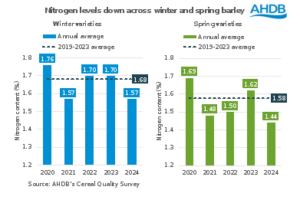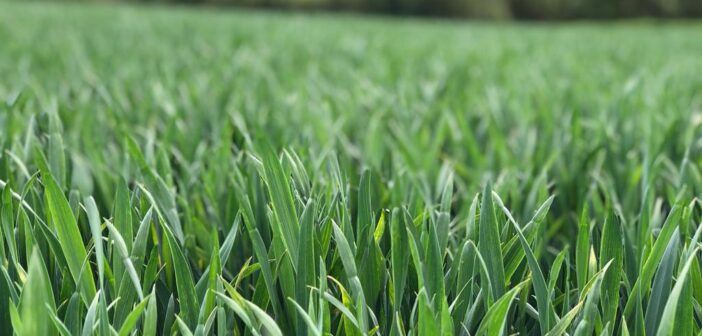The 2024 AHDB Cereal Quality Survey (CQS) confirms harvest reports of low protein for wheat and low nitrogen levels in barley – along with some positive findings.
Persistent wet conditions through autumn and winter at the end of 2023 and beginning of 2024, plus much of spring 2024, meant it was difficult for farmers to get onto fields and apply nutrients. The conditions also increased nitrogen leaching over winter, making it harder for plants to access the nutrients that were applied.
Gabriel Odiase (Analyst, Cereals & Oilseeds) said: “The average protein level for UK Flour Millers group 1 wheat varieties in 2024 is 12.5%, down from the 2023 average of 12.7%. It is also the lowest level since 2014 when proteins declined due to the dilution effect of high yields.

“However, as suggested by reports during harvest, other criteria for wheat in 2024 are improved with higher specific weights and Hagberg Falling Numbers (HFN).
“Average moisture levels are also lower year-on-year, reflecting the generally dry conditions for large parts of the wheat harvest period in England.”
In past seasons with lower protein levels, we have usually seen increased wheat imports with higher contents to blend with UK supplies. AHDB’s Early Balance Sheet forecasts a further increase in imports of wheat, up 163 Kt from 2023/24’s already elevated level, to 2.6 Mt in 2024/25.
AHDB’s Planting and Variety Survey showed a drop around group 1 varieties for harvest 2024. When the information from the two surveys is combined it suggests the area of group 1s effectively meeting flour millers’ typical requirements this season would still be well below average. UK wheat yields were also provisionally lower than in 2023, which could also reduce production.
Importantly, this year’s challenges with ergot – though not captured by this survey – created extra difficulties for growers and the supply chain.
The survey shows lower nitrogen across both winter and spring varieties but contrasting pictures between winter and spring on specific weights and screenings.
For winter barley, the nitrogen content averaged 1.57%, down from 1.70% in 2023, similar to 2021. In addition, specific weights are lower. Winter barley varieties average 63.8kg/hl, down 1.1kg/hl from 2023 and likely the lowest in electronic records (starting from 1996). Average retentions over a 2.5 mm screen, though up on the year, remain below average.
Spring barley samples had an average nitrogen content of 1.44%, also down from 1.62% in 2023 and the lowest in recent years. But there are also improved specific weights and higher retentions over a 2.5mm screen.

Helen Plant (Senior Analyst, Cereals & Oilseeds) said: “For maltsters, low nitrogen levels present more of a challenge to achieve the malt specification that most brewers need.
“It may also be more difficult to export malting barley due to higher continental nitrogen requirements. But industry reports are still positive about the 2024 crop quality, particularly following the 2023 crop.”
Barley moisture levels were notably higher this year, which would have increased drying costs.
The full results of the survey are available on the AHDB Cereal Quality Survey page.




